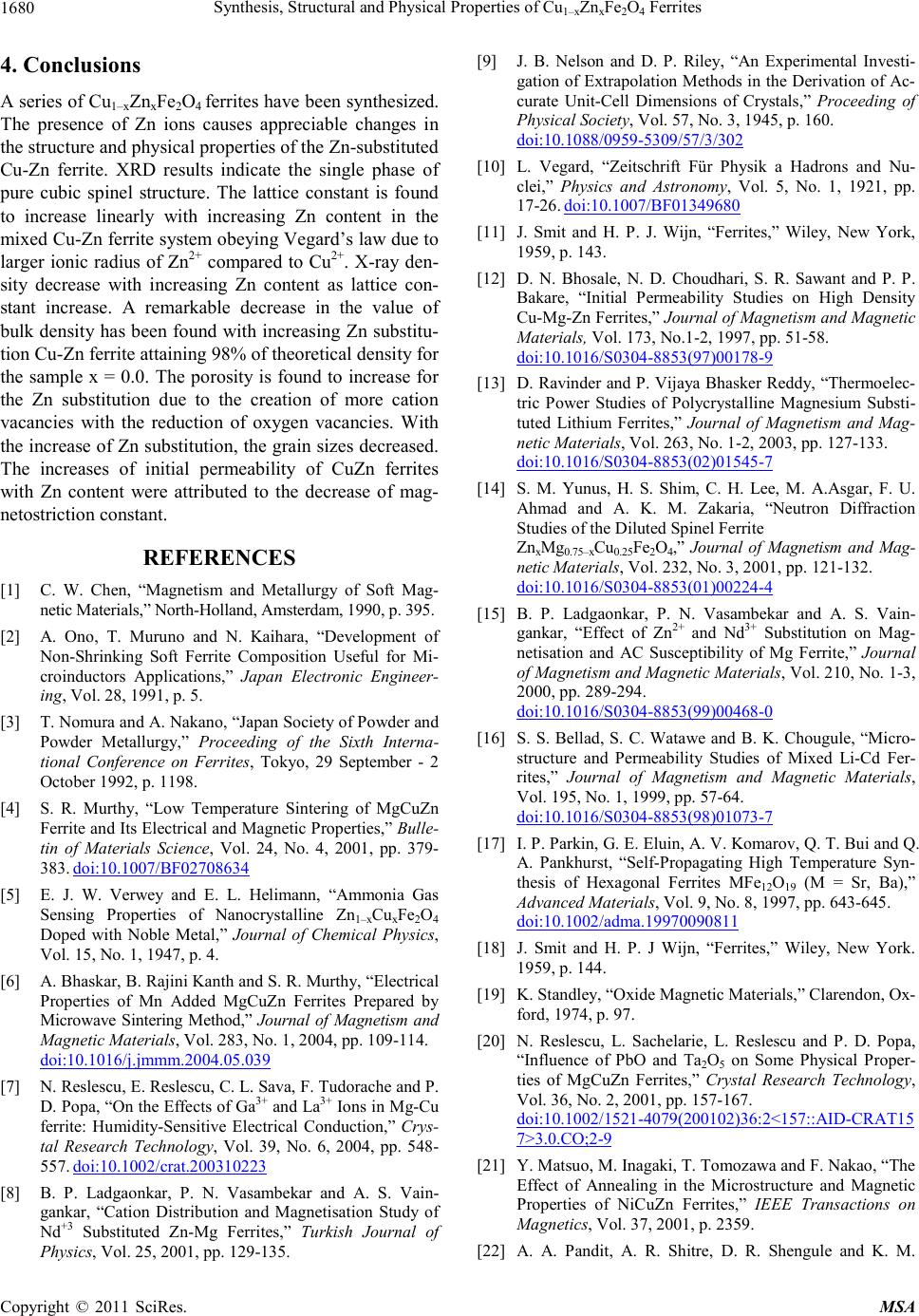
Synthesis, Structural and Physical Properties of CuZn Fe O Ferrites
1680 1–x x2 4
4. Conclusions
A series of Cu1–xZnxFe2O4 ferrites have been synthesized.
The presence of Zn ions causes appreciable changes in
the structure and physical properties of the Zn-substituted
Cu-Zn ferrite. XRD results indicate the single phase of
pure cubic spinel structure. The lattice constant is found
to increase linearly with increasing Zn content in the
mixed Cu-Zn ferrite system obeying Vegard’s law due to
larger ionic radius of Zn2+ compared to Cu2+. X-ray den-
sity decrease with increasing Zn content as lattice con-
stant increase. A remarkable decrease in the value of
bulk density has been found with increasing Zn substitu-
tion Cu-Zn ferrite attaining 98% of theoretical density for
the sample x = 0.0. The porosity is found to increase for
the Zn substitution due to the creation of more cation
vacancies with the reduction of oxygen vacancies. With
the increase of Zn substitution, the grain sizes decreased.
The increases of initial permeability of CuZn ferrites
with Zn content were attributed to the decrease of mag-
netostriction constant.
REFERENCES
[1] C. W. Chen, “Magnetism and Metallurgy of Soft Mag-
netic Materials,” North-Holland, Amsterdam, 1990, p. 395.
[2] A. Ono, T. Muruno and N. Kaihara, “Development of
Non-Shrinking Soft Ferrite Composition Useful for Mi-
croinductors Applications,” Japan Electronic Engineer-
ing, Vol. 28, 1991, p. 5.
[3] T. Nomura and A. Nakano, “Japan Society of Powder and
Powder Metallurgy,” Proceeding of the Sixth Interna-
tional Conference on Ferrites, Tokyo, 29 September - 2
October 1992, p. 1198.
[4] S. R. Murthy, “Low Temperature Sintering of MgCuZn
Ferrite and Its Electrical and Magnetic Properties,” Bulle-
tin of Materials Science, Vol. 24, No. 4, 2001, pp. 379-
383. doi:10.1007/BF02708634
[5] E. J. W. Verwey and E. L. Helimann, “Ammonia Gas
Sensing Properties of Nanocrystalline Zn1–xCuxFe2O4
Doped with Noble Metal,” Journal of Chemical Physics,
Vol. 15, No. 1, 1947, p. 4.
[6] A. Bhaskar, B. Rajini Kanth and S. R. Murthy, “Electrical
Properties of Mn Added MgCuZn Ferrites Prepared by
Microwave Sintering Method,” Journal of Magnetism and
Magnetic Materials, Vol. 283, No. 1, 2004, pp. 109-114.
doi:10.1016/j.jmmm.2004.05.039
[7] N. Reslescu, E. Reslescu, C. L. Sava, F. Tudorache and P.
D. Popa, “On the Effects of Ga3+ and La3+ Ions in Mg-Cu
ferrite: Humidity-Sensitive Electrical Conduction,” Crys-
tal Research Technology, Vol. 39, No. 6, 2004, pp. 548-
557. doi:10.1002/crat.200310223
[8] B. P. Ladgaonkar, P. N. Vasambekar and A. S. Vain-
gankar, “Cation Distribution and Magnetisation Study of
Nd+3 Substituted Zn-Mg Ferrites,” Turkish Journal of
Physics, Vol. 25, 2001, pp. 129-135.
[9] J. B. Nelson and D. P. Riley, “An Experimental Investi-
gation of Extrapolation Methods in the Derivation of Ac-
curate Unit-Cell Dimensions of Crystals,” Proceeding of
Physical Society, Vol. 57, No. 3, 1945, p. 160.
do i:1 0. 10 88 / 09 59 - 53 09 / 57 /3 / 30 2
[10] L. Vegard, “Zeitschrift Für Physik a Hadrons and Nu-
clei,” Physics and Astronomy, Vol. 5, No. 1, 1921, pp.
17-26. doi :1 0. 10 07 / BF01349 68 0
[11] J. Smit and H. P. J. Wijn, “Ferrites,” Wiley, New York,
1959, p. 143.
[12] D. N. Bhosale, N. D. Choudhari, S. R. Sawant and P. P.
Bakare, “Initial Permeability Studies on High Density
Cu-Mg-Zn Ferrites,” Journal of Magnetism and Magnetic
Materials, Vol. 173, No.1-2, 1997, pp. 51-58.
doi:10.1016/S0304-8853(97)00178-9
[13] D. Ravinder and P. Vijaya Bhasker Reddy, “Thermoelec-
tric Power Studies of Polycrystalline Magnesium Substi-
tuted Lithium Ferrites,” Journal of Magnetism and Mag-
netic Materials, Vol. 263, No. 1-2, 2003, pp. 127-133.
doi:10.1016/S0304-8853(02)01545-7
[14] S. M. Yunus, H. S. Shim, C. H. Lee, M. A.Asgar, F. U.
Ahmad and A. K. M. Zakaria, “Neutron Diffraction
Studies of the Diluted Spinel Ferrite
ZnxMg0.75–xCu0.25Fe2O4,” Journal of Magnetism and Mag-
netic Materials, Vol. 232, No. 3, 2001, pp. 121-132.
doi:10.1016/S0304-8853(01)00224-4
[15] B. P. Ladgaonkar, P. N. Vasambekar and A. S. Vain-
gankar, “Effect of Zn2+ and Nd3+ Substitution on Mag-
netisation and AC Susceptibility of Mg Ferrite,” Journal
of Magnetism and Magnetic Materials, Vol. 210, No. 1-3,
2000, pp. 289-294.
doi:10.1016/S0304-8853(99)00468-0
[16] S. S. Bellad, S. C. Watawe and B. K. Chougule, “Micro-
structure and Permeability Studies of Mixed Li-Cd Fer-
rites,” Journal of Magnetism and Magnetic Materials,
Vol. 195, No. 1, 1999, pp. 57-64.
doi:10.1016/S0304-8853(98)01073-7
[17] I. P. Parkin, G. E. Eluin, A. V. Komarov, Q. T. Bui and Q.
A. Pankhurst, “Self-Propagating High Temperature Syn-
thesis of Hexagonal Ferrites MFe12O19 (M = Sr, Ba),”
Advanced Materials, Vol. 9, No. 8, 1997, pp. 643-645.
doi:10.1002/adma.19970090811
[18] J. Smit and H. P. J Wijn, “Ferrites,” Wiley, New York.
1959, p. 144.
[19] K. Standley, “Oxide Magnetic Materials,” Clarendon, Ox-
ford, 1974, p. 97.
[20] N. Reslescu, L. Sachelarie, L. Reslescu and P. D. Popa,
“Influence of PbO and Ta2O5 on Some Physical Proper-
ties of MgCuZn Ferrites,” Crystal Research Technology,
Vol. 36, No. 2, 2001, pp. 157-167.
doi:10.1002/1521-4079(200102)36:2<157::AID-CRAT15
7>3.0.CO;2-9
[21] Y. Matsuo, M. Inagaki, T. Tomozawa and F. Nakao, “The
Effect of Annealing in the Microstructure and Magnetic
Properties of NiCuZn Ferrites,” IEEE Transactions on
Magnetics, Vol. 37, 2001, p. 2359.
[22] A. A. Pandit, A. R. Shitre, D. R. Shengule and K. M.
Copyright © 2011 SciRes. MSA